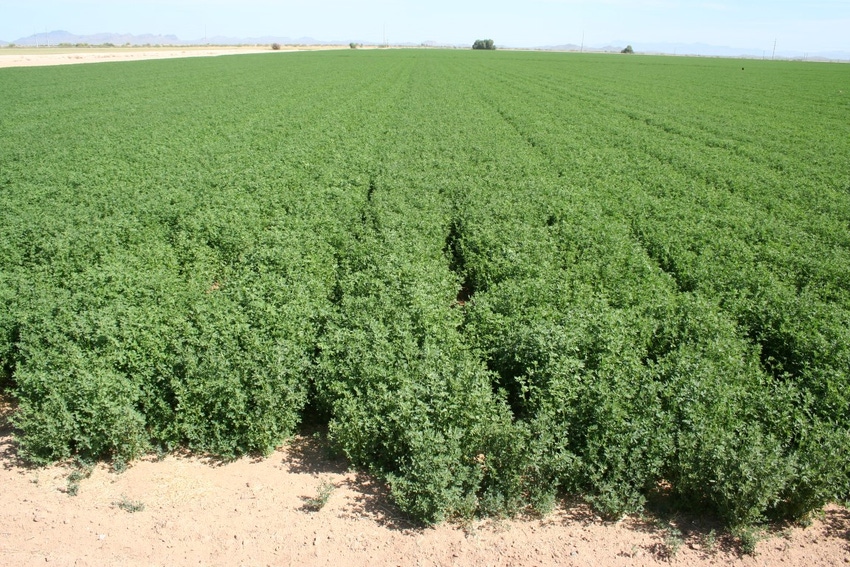May 15, 2015

California’s drought has brought much public attention to the amount of water used in agriculture, and particularly which crops use the most water. Although almonds have taken the hit lately, alfalfa is often one of the favorite whipping boys of agricultural critics due to its high water use on a state-wide basis.
But is alfalfa's water profile really so miserable? The fact is alfalfa doesn’t really use more water than other crops. At full canopy (when the leaves cover the soil surface), alfalfa water use is not much different than other crops, including spinach, lettuce, tomato, wheat, almonds, or corn.
The alfalfa water use profile in California is primarily due to its high acreage and nearly year-round growth pattern in many regions.
If spinach were continually grown on 850,000 to 1 million acres all year long, water use would be about the same as alfalfa, perhaps more.
Further, it's not so much how much water is used, but how much crop is produced per unit of water that is important – also known as water-use efficiency. In this category, alfalfa shines.
Alfalfa has a range of biological characteristics that make it very useful when a farm or an irrigated region is faced with drought conditions and resulting water limitations.
These include:
1 - Deep-rootedness - Alfalfa roots are commonly 3-5 feet deep and can extend to 8-15 feet in some soils. Therefore this crop can utilize deep moisture when surface waters are scarce.
2 – Perenniality - Unlike summer-grown annual crops replanted each year, alfalfa grows for 4-8 years, grows quickly with warm conditions in the spring, and can utilize residual winter rainfall before irrigation is necessary.
3 - Very high yields - Alfalfa is a high yielding crop, and can grow 365 days a year in warm regions. The tons produced per unit of water are thus very high – more crop per drop.
4 - High harvest index, high water use efficiency – Since the entire above-ground plant is harvested, the economic yield per unit of water is high, unlike other crops, where only a portion of the plant is harvested.
5 - Salt tolerance-ability to utilize degraded water - Alfalfa has a high degree of salt tolerance, and can thereby use degraded recycled water (municipal waste water, drain water, other waste water) instead of fresh water.
6. Contribution to wildlife habitat - In a drought, all of nature suffers. Alfalfa has been shown to be a significant wildlife habitat due to its lush foliage and insect diversity. Biologists have determined that 28 percent of California's wildlife use alfalfa for nesting, feeding, or cover. Even partial-season irrigation during drought can assist wildlife in surviving a drought period by using alfalfa as habitat.
Alfalfa benefits wildlife
Don't believe it? Visit an alfalfa field and observe the egrets, curlew, hawks, eagles, snakes, deer, antelope, elk, insects, and many other birds and mammals at home there.
7 - Ability to survive drought - Alfalfa evolved in regions of the world with long, hot dry summers and wet winters exactly like California. Although yields are the highest with full irrigation, alfalfa can survive periodic droughts, due to deep roots and the ability to go ‘summer dormant' under dry conditions.
8 - Ability to deficit irrigate - obtain partial yields - Typically 50-60 percent of full yields are obtained by mid-to-late June. If only partial water is available, irrigation water can be applied early (supplemented by winter rains and residual moisture), and the crop dried down during late summer periods.
Contrary to some views, these positive biological characteristics of alfalfa are quite useful under short water conditions. The high degree of flexibility to ‘deficit irrigate' the crop, the ability to survive drought periods, high water-use efficiency, deep rootedness, salinity tolerance, and the ability to utilize degraded water make alfalfa particularly valuable in a drought.
It is also very valuable to the millions of consumers who depend upon milk, cheese, yogurt, and ice cream produced from alfalfa.
(Editor’s note: This is a condensed version of the Dan Putnam’s full article. Read the article in its entirety at http://ucanr.edu/blogs/blogcore/postdetail.cfm?postnum=17721.
You May Also Like




